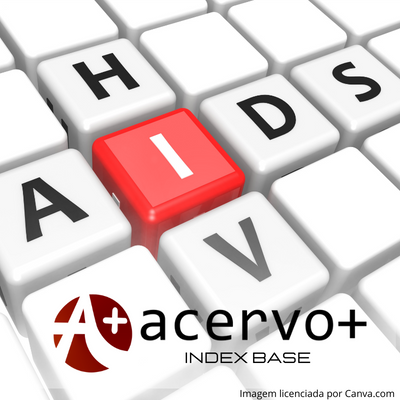Epidemiologia da mortalidade pelo HIV/AIDS no Brasil entre os anos de 2016 e 2021: uma revisão integrativa
##plugins.themes.bootstrap3.article.main##
Resumo
Objetivo: Analisar o padrão/taxa de mortalidade em pacientes HIV positivo no Brasil, no período de 2016 até 2021. Métodos: Foram realizadas pesquisas em quatro bases de dados (MEDLINE, LILACS, Embase e Scopus), sendo selecionados os estudos relevantes para a temática. Resultados: Verificou-se que a mortalidade por HIV/AIDS se relaciona, em sua maioria, com uma segunda infecção, como tuberculose e histoplasmose, além da associação com a não adesão à TARV. Somando-se a isso, constatou-se uma maior prevalência de óbitos entre adultos do sexo masculino, entre pretos e pardos, pessoas com baixo nível de escolaridade e moradores das regiões Norte e Nordeste. Considerações finais: Diante desse contexto, esse estudo pode ser útil para o melhor planejamento de políticas públicas voltadas para pessoas que vivem com HIV/AIDS, contribuindo também para o conhecimento de profissionais e acadêmicos da área da saúde acerca do padrão epidemiológico da mortalidade por essa condição, a fim de que haja a redução da mortalidade por HIV/AIDS no Brasil e a melhora na qualidade de vida dessas pessoas.
##plugins.themes.bootstrap3.article.details##
Copyright © | Todos os direitos reservados.
A revista detém os direitos autorais exclusivos de publicação deste artigo nos termos da lei 9610/98.
Reprodução parcial
É livre o uso de partes do texto, figuras e questionário do artigo, sendo obrigatória a citação dos autores e revista.
Reprodução total
É expressamente proibida, devendo ser autorizada pela revista.
Referências
2. ALVES C, et al. A aplicação e o conceito de raça em saúde pública: definições, controvérsias e sugestões para uniformizar sua utilização nas pesquisas biomédicas e na prática clínica. Gazeta Médica da Bahia, 2005; 74(1): 92-115.
3. BOIGUES BCS, et al. Clinical outcomes and risk factors for death from disseminated histoplasmosis in patients with AIDS who visited a high-complexity hospital in Campo Grande, MS, Brazil. Revista da Sociedade Brasileira de Medicina Tropical, 2018; 51(2): 155-161.
4. BRASIL. MINISTÉRIO DA SAÚDE. Secretaria de Vigilância em Saúde. Departamento de Doenças de Condições Crônicas e Infecções Sexualmente. Boletim epidemiológico: HIV/Aids 2020. 2020. Disponível em: http://www.aids.gov.br/pt-br/pub/2020/boletim-epidemiologico-hivaids-2020. Acessado em: 17 de outubro de 2021.
5. COSTA VS, et al. AIDS in the meeting of the Tapajós and Amazon rivers: deaths in the period 2010-2018 in Santarém, Pará, Brazil. ABCS Health Sciences, 2021; 46: e021201.
6. CUNHA AP, et al. Análise da tendência da mortalidade por HIV/AIDS segundo características sociodemográficas no Brasil, 2000 a 2018. Ciência & Saúde Coletiva, 2022; 27: 895-908.
7. FERREIRA MD, et al. Preditores de mortalidade em pacientes da unidade de terapia intensiva coinfectados por tuberculose e HIV. Jornal Brasileiro de Pneumologia, 2018; 44(2): 118-124.
8. GAMA WM, et al. Immunologic biomarkers, morbidity and mortality among HIV patients hospitalised in a Tertiary Care Hospital in the Brazilian Amazon. BMC Infectious Diseases, 2021; 21(1): 1-9.
9. HAGUIHARA T, et al. Factors associated with mortality in HIV patients failing antiretroviral therapy, in Salvador, Brazil. Brazilian Journal of Infectious Diseases, 2019; 23(3): 160-163.
10. HODA SA, GINTER PS. Robbins and cotran pathologic basis of disease. American Journal of Clinical Pathology, 2015; 144(1): 172.
11. JUNIOR GBS, et al. Acute kidney injury and other factors associated with mortality in hiv-infected patients. Revista da Associação Médica Brasileira, 2018; 64(6): 509-517.
12. KNAUTH DR, et al. O diagnóstico do HIV/aids em homens heterossexuais: a surpresa permanece mesmo após mais de 30 anos de epidemia. Cadernos de Saúde Pública, 2020; 36(8): e00170118.
13. MACHADO CAL, et al. Epidemiological profile and lethality of visceral leishmaniasis/human immunodeficiency virus co-infection in an endemic area in Northeast Brazil. Revista da Sociedade Brasileira de Medicina Tropical, 2021; 54: e0795.
14. MEDEIROS ARC, et al. Insegurança alimentar moderada e grave em famílias integradas por pessoas vivendo com HIV/Aids: validação da escala e fatores associados. Ciência & Saúde Coletiva, 2017; 22: 3353-3364.
15. MEDEIROS RCSC, et al. Quality of life, socioeconomic and clinical factors, and physical exercise in persons living with HIV/AIDS. Revista de Saúde Pública, 2017; 51: 1-7.
16. MONTANA JF, et al. The HIV epidemic in Colombia: spatial and temporal trends analysis. BMC public health, 2021; 21(1): 1-14.
17. MOREIRA LR. Manual de revisão bibliográfica sistemática integrativa: a pesquisa baseada em evidências. Belo Horizonte: Anima Educação, 2014; 63p.
18. PEREIRA BS, et al. Fatores associados à infecção pelo HIV/AIDS entre adolescentes e adultos jovens matriculados em Centro de Testagem e Aconselhamento no Estado da Bahia, Brasil. Ciência & Saúde Coletiva, 2014; 19: 747-758.
19. POOROLAJAL J, et al. Predictors of progression to AIDS and mortality post-HIV infection: a long-term retrospective cohort study. AIDS Care, 2015; 27(10): 1205-1212.
20. RICE B, et al. Trends in HIV diagnoses, HIV care, and uptake of antiretroviral therapy among heterosexual adults in England, Wales, and Northern Ireland. Sexually transmitted diseases, 2014; 41(4): 257-265.
21. VILLARINHO MV, et al. Políticas públicas de saúde face à epidemia da AIDS e a assistência às pessoas com a doença. Revista Brasileira de Enfermagem, 2013; 66(2): 271-277.

